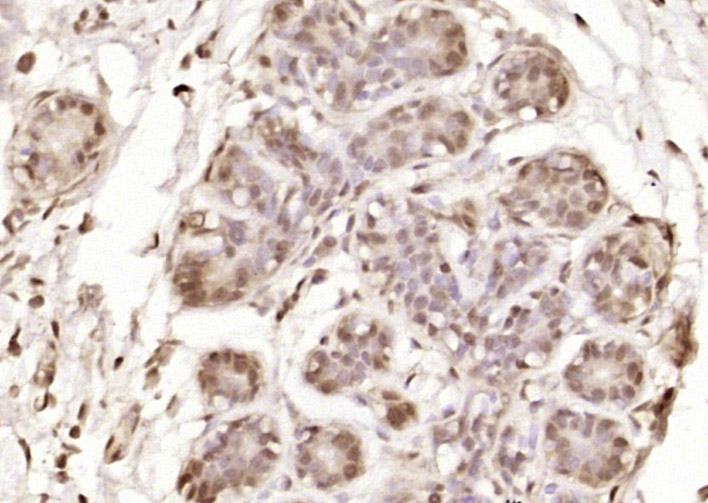OGDH Rabbit pAb
OGDH Rabbit pAb
- 产品详情
- 实验流程
- 背景知识
Application
| IHC-P, IHC-F, IF |
|---|---|
| Primary Accession | Q02218 |
| Reactivity | Human |
| Predicted | Pig, Horse, Sheep |
| Host | Rabbit |
| Clonality | Polyclonal |
| Calculated MW | 115935 Da |
| Physical State | Liquid |
| Immunogen | KLH conjugated synthetic peptide derived from human OGDH |
| Epitope Specificity | 931-1023/1023 |
| Isotype | IgG |
| Purity | affinity purified by Protein A |
| Buffer | 0.01M TBS (pH7.4) with 1% BSA, 0.02% Proclin300 and 50% Glycerol. |
| SUBCELLULAR LOCATION | Mitochondrion matrix. |
| SIMILARITY | Belongs to the alpha-ketoglutarate dehydrogenase family. |
| Important Note | This product as supplied is intended for research use only, not for use in human, therapeutic or diagnostic applications. |
| Background Descriptions | This gene encodes one subunit of the 2-oxoglutarate dehydrogenase complex. This complex catalyzes the overall conversion of 2-oxoglutarate (alpha-ketoglutarate) to succinyl-CoA and CO(2) during the Krebs cycle. The protein is located in the mitochondrial matrix and uses thiamine pyrophosphate as a cofactor. A congenital deficiency in 2-oxoglutarate dehydrogenase activity is believed to lead to hypotonia, metabolic acidosis, and hyperlactatemia. Alternative splicing results in multiple transcript variants encoding distinct isoforms.[provided by RefSeq, Sep 2009] |
| Gene ID | 4967 |
|---|---|
| Other Names | 2-oxoglutarate dehydrogenase complex component E1, E1o, HsOGDH, OGDC-E1, OGDH-E1, 1.2.4.2, 2-oxoglutarate dehydrogenase, mitochondrial, Alpha-ketoglutarate dehydrogenase, Alpha-KGDH-E1, Thiamine diphosphate (ThDP)-dependent 2-oxoglutarate dehydrogenase, OGDH (HGNC:8124) |
| Dilution | IHC-P=1:100-500,IHC-F=1:100-500,IF=1:100-500 |
| Storage | Store at -20 °C for one year. Avoid repeated freeze/thaw cycles. When reconstituted in sterile pH 7.4 0.01M PBS or diluent of antibody the antibody is stable for at least two weeks at 2-4 °C. |
| Name | OGDH (HGNC:8124) |
|---|---|
| Function | 2-oxoglutarate dehydrogenase (E1o) component of the 2- oxoglutarate dehydrogenase complex (OGDHC) (PubMed:24495017, PubMed:25210035, PubMed:28435050). Participates in the first step, rate limiting for the overall conversion of 2-oxoglutarate to succinyl-CoA and CO(2) catalyzed by the whole OGDHC (PubMed:24495017, PubMed:25210035, PubMed:28435050). Catalyzes the irreversible decarboxylation of 2-oxoglutarate (alpha-ketoglutarate) via the thiamine diphosphate (ThDP) cofactor and subsequent transfer of the decarboxylated acyl intermediate on an oxidized dihydrolipoyl group that is covalently amidated to the E2 enzyme (dihydrolipoyllysine- residue succinyltransferase or DLST) (PubMed:24495017, PubMed:25210035, PubMed:28435050, PubMed:35272141). Plays a key role in the Krebs (citric acid) cycle, which is a common pathway for oxidation of fuel molecules, including carbohydrates, fatty acids, and amino acids (PubMed:25210035). Can catalyze the decarboxylation of 2-oxoadipate in vitro, but at a much lower rate than 2-oxoglutarate (PubMed:28435050). Mainly active in the mitochondrion (PubMed:29211711). A fraction of the 2-oxoglutarate dehydrogenase complex also localizes in the nucleus and is required for lysine succinylation of histones: associates with KAT2A on chromatin and provides succinyl-CoA to histone succinyltransferase KAT2A (PubMed:29211711). |
| Cellular Location | Mitochondrion. Nucleus. Note=Mainly localizes in the mitochondrion. A small fraction localizes to the nucleus, where the 2- oxoglutarate dehydrogenase complex is required for histone succinylation. |
For Research Use Only. Not For Use In Diagnostic Procedures.
Provided below are standard protocols that you may find useful for product applications.
BACKGROUND
This gene encodes one subunit of the 2-oxoglutarate dehydrogenase complex. This complex catalyzes the overall conversion of 2-oxoglutarate (alpha-ketoglutarate) to succinyl-CoA and CO(2) during the Krebs cycle. The protein is located in the mitochondrial matrix and uses thiamine pyrophosphate as a cofactor. A congenital deficiency in 2-oxoglutarate dehydrogenase activity is believed to lead to hypotonia, metabolic acidosis, and hyperlactatemia. Alternative splicing results in multiple transcript variants encoding distinct isoforms.[provided by RefSeq, Sep 2009]
终于等到您。ABCEPTA(百远生物)抗体产品。
点击下方“我要评价 ”按钮提交您的反馈信息,您的反馈和评价是我们最宝贵的财富之一,
我们将在1-3个工作日内处理您的反馈信息。
如有疑问,联系:0512-88856768 tech-china@abcepta.com.























 癌症的基本特征包括细胞增殖、血管生成、迁移、凋亡逃避机制和细胞永生等。找到癌症发生过程中这些通路的关键标记物和对应的抗体用于检测至关重要。
癌症的基本特征包括细胞增殖、血管生成、迁移、凋亡逃避机制和细胞永生等。找到癌症发生过程中这些通路的关键标记物和对应的抗体用于检测至关重要。 为您推荐一个泛素化位点预测神器——泛素化分析工具,可以为您的蛋白的泛素化位点作出预测和评分。
为您推荐一个泛素化位点预测神器——泛素化分析工具,可以为您的蛋白的泛素化位点作出预测和评分。 细胞自噬受体图形绘图工具为你的蛋白的细胞受体结合位点作出预测和评分,识别结合到自噬通路中的蛋白是非常重要的,便于让我们理解自噬在正常生理、病理过程中的作用,如发育、细胞分化、神经退化性疾病、压力条件下、感染和癌症。
细胞自噬受体图形绘图工具为你的蛋白的细胞受体结合位点作出预测和评分,识别结合到自噬通路中的蛋白是非常重要的,便于让我们理解自噬在正常生理、病理过程中的作用,如发育、细胞分化、神经退化性疾病、压力条件下、感染和癌症。






